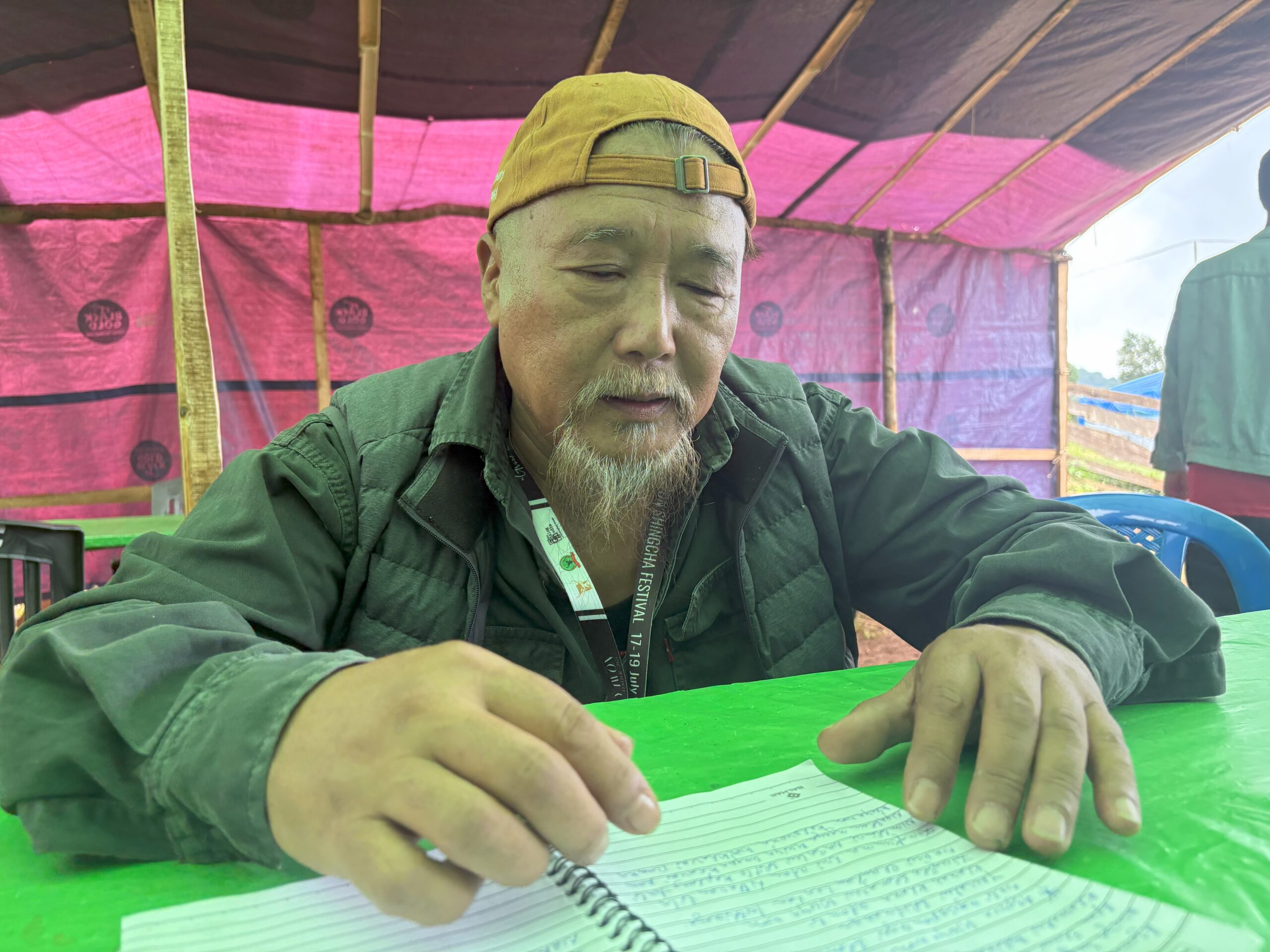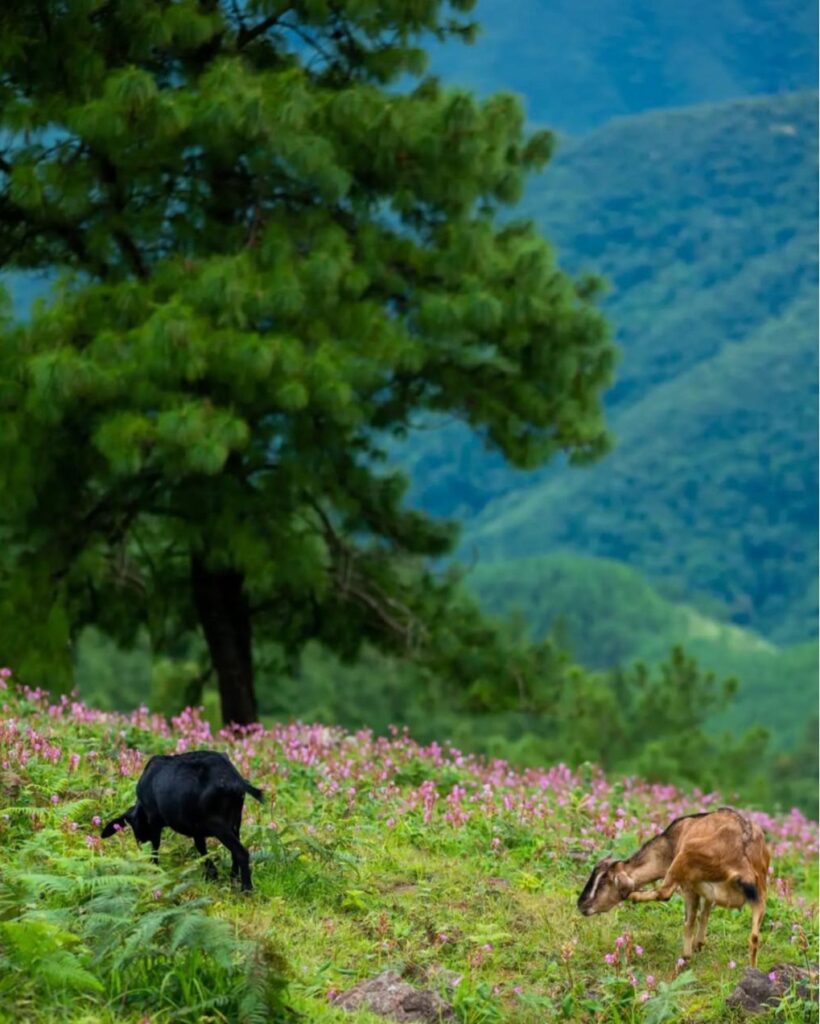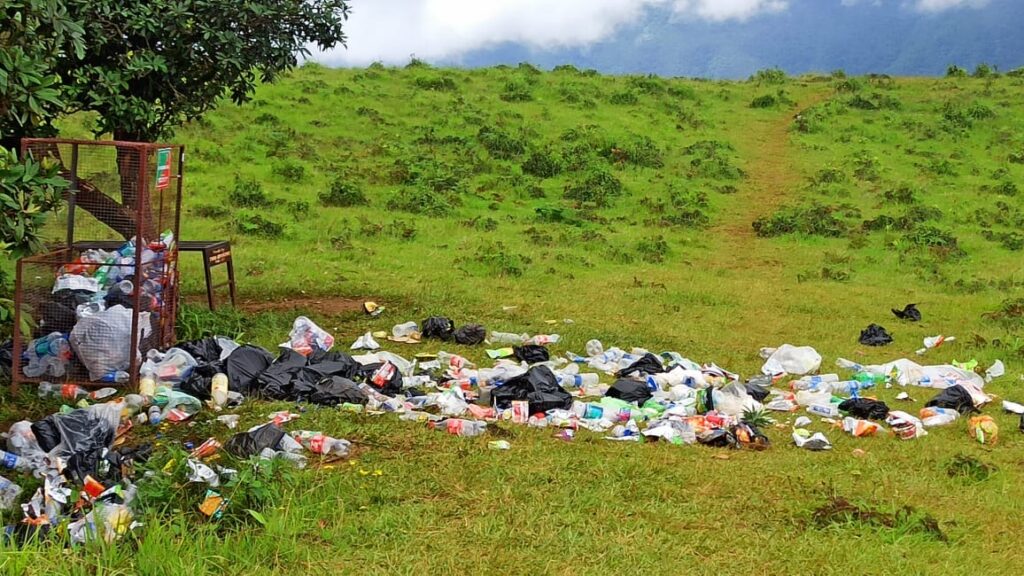EKHON
Azarva wuyawon wuili yaothuivāsa
Muiyā ungpakhavai Wuya kaphung tungli
Apam chiwui thingrong bingla kaoka serra
Khamakui masina pangda kaphan pamli.
Ukhrul | July 22, 2025: During a casual meeting with Padmashri Awardee Guru Rewben Mashangva at Shingcha village, he shared a touching poem, a tribute to Wuyawon, the pink ginger flower that thrives on Mount Wuya Kachui in Manipur’s Kamjong District. His poem beautifully captures the flower’s resilience, braving the fierce winds, relentless rains, and swirling mists.
Over steaming coffee and citrus tea, we discussed the habit of the flower, its resiliency and declining bloom. The flower, found in Shingcha and surrounding villages like Khorung in Khangkhui and Kazing Malung in Pushing, is identified with Wuyawon named after its association with Mount Wuya Kachui where it was first identified to the public.
‘I have visited this place before. I have been inspired to write a poem about its unique environment. It’s just been less than a decade since the Wuyawon gained recognition, thanks to Phila and Mayo’s discovery. In my poem, I affectionately call the flower ‘Azarva‘ or younger sister, given its recent discovery and fleeting nature. Locals recall that the flower was briefly spotted during World War II, only to disappear and be rediscovered decades later’, noted Padmashri Awardee.

He penned the lyrics to entice visitors to experience the mountain’s breathtaking beauty and delicate flowers.
“I wrote the sentence ‘Let us visit younger sister Wuyawon‘ to spark curiosity among visitors, even if they’ve never seen the flower. My poem captures the essence of the place, with different nuances. In one part, I wrote ‘We shall visit again’ as a polite farewell, hinting that the harsh winds and cold make it impossible to linger for long at the mountain top.”
He went on to elaborate the character of the flower saying ‘The elements of rain, clouds, and wind are like the flower’s attire, and it thrives in harmony with nature. While strong trees struggle against the fierce winds and stand crooked and protruded, the delicate Wuyawon is spared, untouched by the harsh winds. Strangely nature seems to favor the Wuyawon, shielding it from harm and thriving in total bliss’.
Interestingly, locals revealed that Mount Wuya Kachui was previously overgrown with bushes until the introduction of cows and goats, which cleared the land and led to the discovery of the delicate pink Wuyawon. The cattle, by grazing on surrounding vegetation without harming the Wuyawon, inadvertently created a conducive environment for them to thrive, resulting in a unique landscape that has captivated visitors with its scenic beauty.

There is a visible decline in the flower’s growth this year which could be due to an increase in footfall from visitors or potential climate change, however locals have varied ideas, some attributing the natural fluctuation like change in rainfall pattern and other factors.
‘We are speculating about the possibilities of the decline, but it is possible that it is a natural fluctuation, some years are good, some are not. Still, we can’t entirely rule out the impact of climate change on the decline of Wuyawon’, stated Phila Awungshi, a local.
Nganaomi Kasar, former Shingcha Katamnao Long President, during whose tenure the Wuyawon festival began, observed no significant climate change but speculated that factors like the absence of controlled forest fires might be contributing to the flower’s decline.
‘For three years prior to the festival, we noticed that controlled forest fires promoted Wuyawon growth by clearing overgrown bushes. However, this year, at the forest department’s behest to prevent deforestation, we refrained from setting controlled fires, a traditional practice for managing forests and habitats. This absence of fire could potentially be a reason for the flower’s decline’, observed Kasar, now advisor to the Shingcha Katamnao Long.
‘This year, fewer cattle grazed on the mountain slope, which could be another contributing factor to the decline. We’ve often joked that the cattle deserve appreciation for preserving the Wuyawon, as they play a crucial role in maintaining their health’, added Kasar amidst laughter.

The flower’s striking growth around serpentinite rocks is noteworthy, given the soil’s conditions which are said to be generally low in nutrients with high presence of heavy metals. Yet, Wuyawon thrives, indicating unique adaptations that enable it to tolerate toxic metals and take advantage of lesser competition. This rare ecological relationship highlights the remarkable resilience of native flora, making Shingcha a hidden botanical wonder worthy of protection and further study.
Kasar noted that the presence of chromite seems to facilitate the growth of Wuyawon, observing that it thrives in areas with high chromite content like Khorung (Khangkhui), Kazing Malung (Pushing), and a location at Poi. Like the Shirui Lily, it appears to be sensitive to its environment and struggles to survive elsewhere. Although not a researcher, Kasar experimented by planting Wuyawon in pots with the soil from its habitat and found it could survive only for a few seasons, suggesting that chromite plays a crucial role in supporting the flower’s growth.
Mount Wuya Kachui is a dream come true, with pink flowers blanketing the slope and clouds gently drifting by, creating a postcard-perfect scene that’s nothing short of breathtaking. Perhaps the flowers and the mountain are indeed protected by a spirit, as the oral traditions and stories passed down to the younger generation would have us believe.
Regardless of the tales, the locals of Shingcha have a significant responsibility to restore and preserve the ecosystem of the mountain slopes, which are rich in geo heritage and to protect the unique biodiversity and natural wonders like the Wuyawon.
‘Shingcha Village has strong potential to promote geotourism because it is one of the few places in Northeast India where serpentinite rocks, a type of rare oceanic rock, are exposed. These rocks are significant as they originate from the Earth’s oceanic crust and are usually found in tectonic plate boundaries, making them geologically important. Their presence in Shingcha offers a unique opportunity for students, researchers, and tourists to study the remnants of ancient oceanic lithosphere uplifted onto land. This rare geological feature, combined with the village’s natural beauty and cultural richness, makes Shingcha an ideal site for educational and sustainable geotourism’, stated a local geologist.
Locals like Phila Awungshi are disheartened that visitors leave behind trash and leftovers, marring the otherwise pristine beauty of the mountain.

‘With only 20 local youths managing the festival, including ticketing, events, and visitor handling, cleaning the entire mountain proved to be a daunting task’, lamented Awungshi.
She expressed her hope that visitors would be more environmentally conscious and have a responsible attitude towards the ecosystem.
Like Padmashri Awardee Guru Rewben Mashangva, we too can wish for the Wuyawon to bloom vibrantly every year on Mount Wuya Kachui, where the mist gently caresses the landscape, where we can bask in its serene beauty.
Azarva wuyawon wuili yaothuivāsa
Muiya ungpakhavai Wuya kaphung tungli
Apam chiwui thingrong bingla kaoka serra
Khamakui masina pangda kaphan pamli
Azarva Wuyawon
Nali ngasopam ngaishonna
Yaorālui shitnaoka
Khanao khanā atamli
Zingsho shongwui Wuyawon
Nawui chānhān Lāhān leishināya.
Zingkumma wui atam hitharan lila
Nimshiri wonsalui shitlo kaphung tungli
Ngashun ngaya muiyā ungpa khavai pam
Wuyawon kahova wonkhavai ramna.
Zurkachang atam wui marang kachangli
Ngahuiri rāwonmi chinglo oh Wuyawon
Zinghām zingrot muiyā china kachon sai
Masinala awui michang zangmi dalei
Azarva Wuyawon
Nali ngasopam ngaishonna
Yaorālui shitnaoka
Khanao khanā atamli
Zingsho shongwui Wuyawon
Nawui chānhān lāhān leishināya.
By Jenny Thingshung (The author can be reached at Jenny.thingshung@gmail.com.)
This Article is written under the joint initiative of Directorate of Environment & Climate Change, Media Resource Centre Government of Manipur and Ukhrul District Working Journalist Association.
